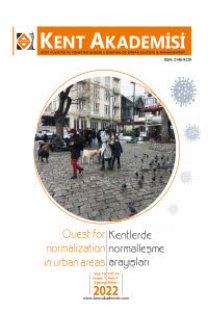Sanatsal Bir İfade Aracı Olarak Cam Malzemenin Anlatım Olanakları
Bu çalışmada cam alanında Endüstri Devrimi’nin etkilerinin görülmeye başlandığı 1900’lerden bugüne, malzemenin sanatsal anlamda dönüşümü ve değişen anlayışların sanatçıların eserleri üzerinden değerlendirilmesi yapılmıştır. Ayrıca bu değerlendirmede cama özgü ifade olanaklarının keşfinde özellikle 20.Yüzyıldan itibaren başlayan dönüşümünün yanında, camın plastik sanatlar alanı içinde konumlanışıyla ilgili bağlantılar da ortaya konmuştur. Camın işlevselliğe dayalı yaklaşımlardan ayrışarak sanat alanı içinde de bir varlık alanı oluşturması 20.Yüzyılda başlayan birikimlerin sonucu olarak yorumlanabilir. Bu bağlamda araştırmada özellikle 1960’lı yıllardan sonra cama özgü şeffaflık, optik etkiler, kırılganlık, plastisite gibi biçimsel ve kavramsal bağlamda anlatım olanaklarının sorgulayan sanatçılar ve onların eserleri üzerinden, 21.Yüzyılda camın sanatsal potansiyelini geliştirmeye yönelik katkılar değerlendirilmiştir. Sanat eserleri üzerinde yapılan değerlendirmelerde; camın heykel formlarında kullanımıyla belirginleşip öne çıkan; şeffaflık, optik etkiler, kırılganlık, plastisite gibi özelliklerinin hem teknik hem de içerik bağlamında forma verdiği katkılar ve ifade olanakları yorumlanarak aktarılmıştır. Bugün gelinen noktada teknolojinin evrimine paralel gelişmelere açık bir alan olan cam, yeni olanakların keşfine açık yönüyle sanat alanında ilham verici ve cezbedici yönünü koruyacaktır.
Anahtar Kelimeler:
Cam sanatı, Şeffaflık, Optik etkiler, Kırılganlık, Plastisite
Potential Uses Of Glass As A Medium For Artistic Expression
ABSTRACT
This study evaluates the artistic transformation of glass material and changing conceptions and approaches since 1900s, during which the effects of the Industrial Revolution on glass industry started to become remarkably apparent, by analyzing available works of artists. In addition, this evaluation highlights the links between the exploration of potential ways of artistic expressions unique to glass material and the evolution of this transformation as of the 20th century and the integration of glass into the field of plastic arts. It might be concluded that the integration of glass material into the field of art by freeing itself from the traditional approaches based on its functionality is the outcome of the developments as of the 20th century. Thus, the present study aims to evaluate the contributions of some unique features of glass such as transparency, optical effects, fragility and plasticity to the development of artistic potential of glass in the 21st century – especially after 1960s- by analyzing the artists who question these potential uses and their works of art. The evaluations made through works of art focus on these innovative forms of artistic expression realized by using glass and how its prominent features such as transparency, optical effects, fragility and plasticity contribute to form both in terms of content and technical use. Today, it is no doubt that glass will continue to be inspiring and tempting in the field of art since it is open to developments in parallel with technological evolution as well as the exploration of new ways of artistic expression.
Keywords:
Glass Art, Transparency, Optical Effects, Fragility, Plasticity,
___
- Görsel.1 “Stanislav Libensky Jaroslava Brychtova: A 40 Year Collaboration in Glass”, Corning Museum of Glass, New York and Prestel-Verlag,Munich-New York, s. 136-137, 1994
- Görsel.2 “Stanislav Libensky Jaroslava Brychtova: A 40 Year Collaboration in Glass”, Corning Museum of Glass, New York and Prestel-Verlag,Munich-New York, s. 138-139, 1994
- Görsel.3 Susanne K. Frantz “Sphere in a cube (1978)”, “Stanislav Libensky Jaroslava Brychtova: A 40 Year Collaboration in Glass”, Corning Museum of Glass, New York and Prestel-Verlag,Munich-New York, s.157, 1994 ve Mustafa Ağatekin Fotoğraf arşivi.
- Görsel.4 Stephan Pala New Glass Art& Architecture No:4 s.40 2020, Richard Whiteley New Glass Art& Architecture No:4 s.13 2015, Han De Kluijver New Glass Art& Architecture No:2 s.18, 2021
- Görsel.5 Indre Stulgaite New Glass Art& Architecture No:2&3 s.64 2020, Mona Hatoum, https://www.phaidon.com/agenda/art/articles/2016/may/03/3-cool-mona-hatoum-works-in-the-new-tate-show/ Erişim Tarihi: 19.06.2022, Kazue Taguchi “Freischwimmer” (2012) https://www.berlinartlink.com/2012/12/15/kazue-taguchi-the-contemplation-of-ephemeral-and-infinite-light-strokes/ Erişim Tarihi: 30.03.2022
- Görsel.6 Stephan Knapp http://www.lightpaintings.com/ Erişim Tarihi: 30.03.2022, Bernd Weinmayer New Glass Art& Architecture No:2&3 s.50 2020
- Görsel.7 Marc Barreda New Glass Art& Architecture No:2 cover 2015, Gyorgy Gaspar New Glass Art& Architecture No:2 s.26 2015, Peter Borkovics https://www.artsy.net/artist/peter-borkovics Erişim Tarihi: 30.03.2022
- Görsel.8 Rob Mulholland https://www.flickr.com/photos/guinavere/20675843792/in/photostream/ erişim tarihi: 06.04.2022, Jin Hongo https://northlandscreative.co.uk/2020/11/05/glass-lives-interview-jin-hongo/ Erişim Tarihi: 06.04.2022
- Görsel.9 Simon Berger https://www.simonberger.art/exhibitions-simonberger Erişim Tarihi: 05.04.2022, George Papadopoulos Lamination A&C Black Glass Handbooks s:82 London 2004.
- Görsel.10 Baptiste Debombourg https://www.juxtapoz.com/news/glass-like-water-aerial-by-baptiste-debombourg-/ Erişim Tarihi: 19.06.2022
- Görsel.11 Anne Petters https://northlandscreative.co.uk/2020/11/03/glass-lives-interview-anne-petters/ Erişim Tarihi 05.04.2022, Brent Kee Young https://brentkeeyoung.com/artwork/1970452_Matrix_Series_Respite.html Erişim Tarihi 05.04.2022.
- Görsel.12 Luba Bakicova https://www.glassart.de/glass-artist-luba-bakicova/ Erişim Tarihi26.04.2022, Michael Petry, “Contemporary Glass, Black Dog Publishing, London, United Kingdom, s: 167, 2008.
- Görsel.13 Keith Cummings, A History of Glass, A&C Black, The University of Pennsylvania Press, Philadelphia,s: 180, 2002
- ISSN: 2146-9229
- Yayın Aralığı: Yılda 4 Sayı
- Başlangıç: 2008
- Yayıncı: Karadeniz Yazarlar ve Şairler Derneği
Sayıdaki Diğer Makaleler
Biyofilik Tasarım Konulu Lisansüstü Tezlerin Bibliyometrik Analizi
Güncel Sorunlara “Klasik” Bir Çözüm: İstanbul, Beykoz’da Enformel Cami Üretiminden Örnekler
Meryem ODABAŞI, Göksun AKYÜREK
İklim Değişikliği ile Mücadele Kapsamında İzmir’de Biyoenerji Odaklı Akıllı Uzmanlaşma Potansiyeli
Halil İbrahim Murat ÇELİK, Günnur KOCAR
Kentli Tüketim Toplumu Eleştirisi Olarak Martin Crimp Tiyatrosu
Toplu Taşıma Araçları Sefer Sıklığı Belirleme ve Çizelgeleme Problemi
Veba’dan Covid-19’a Salgın Hastalıkların Kent ve Kent Hayatı ile İlişkisi
